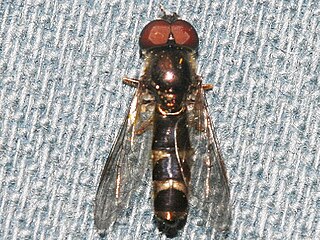
Platycheirus clypeatus is a species of hoverfly. It is found across the Palearctic and in the Nearctic. The larvae feed on aphids. Adults are usually found on the edges of woodland or scrub, heath or along hedgerows where they visit a wide range of flowers.

Platycheirus is a large genus of hoverflies. They are also called sedgesitters.

Platycheirus angustatus is a species of hoverfly. It is found in many parts of the Palearctic, and in the Nearctic.
Platycheirus perpallidus is a species of hoverfly. It is a Holarctic species.

Temnostoma venustum , the Black-banded Falsehorn , is a rare species of syrphid fly observed in the northeastern United States and adjacent Canada. Hoverflies can remain nearly motionless in flight. The adults are also known as flower flies for they are commonly found on flowers, from which they get both energy-giving nectar and protein rich pollen. Temnostoma adults are strong wasp mimics The larvae burrow in moist decayed wood.
Criorhina nigriventris , the bare-cheeked bumble fly, is an uncommon species of syrphid fly observed across the northern United States, the Appalachian Mountains and southern Canada. Hoverflies can remain nearly motionless in flight. The adults are also known as flower flies for they are commonly found on flowers, from which they get both energy-giving nectar and protein-rich pollen. The larvae of this genus are found in decaying wood.

Temnostoma barberi , the Bare-bellied Falsehorn, is a fairly common species of syrphid fly (hoverfly) observed in the eastern half of the United States and adjacent areas of Canada. Hoverflies can remain nearly motionless in flight. The adults are also known as flower flies for they are commonly found on flowers, from which they get both energy-giving nectar and protein-rich pollen. Temnostoma adults are strong wasp mimics. The larvae burrow in moist decayed wood.
Lejota cyanea , the Cobalt Trunksitter, is an uncommon species of syrphid fly observed in the northeast and west coast of North America. Hoverflies can remain nearly motionless in flight. The adults are also known as flower flies for they are commonly found on flowers, from which they get both energy-giving nectar and protein-rich pollen. The larvae of this genus are found in decaying tree roots.
Platycheirus inversus, also known as the knobfoot sedgesitter, is a rare species of syrphid fly observed in Northeastern North America. Hoverflies can remain nearly motionless in flight. The adults are also known as flower flies for they are commonly found on flowers, from which they get both energy-giving nectar and protein-rich pollen. Larvae are aphid predators.
Platycheirus modestus , also known as the yellow sedgesitter, is an uncommon species of syrphid fly observed throughout Northern North America. Hoverflies can remain nearly motionless in flight. The adults are also known as flower flies for they are usually found on flowers from which they get both energy-giving nectar and protein-rich pollen. Larvae are aphid predators.
Platycheirus nearcticus, the Nearctic broadhand sedgesitter, is a common species of syrphid fly observed in mainly in northeastern North America but scattered more broadly across the continent. Hoverflies can remain nearly motionless in flight. The adults are also known as flower flies for they are commonly found on flowers from which they get both energy-giving nectar and protein rich pollen. Larvae are aphid predators.
Platycheirus nodosus, known as the twospear sedgesitter, is an uncommon species of syrphid fly observed in Canada and The Rocky Mountains. Hoverflies can remain nearly motionless in flight. The adults are also known as flower flies for they are commonly found on flowers from which they get both energy-giving nectar and protein-rich pollen. Larvae are aphid predators.
Platycheirus normae, the paddlearm sedgesitter, is a rare species of syrphid fly observed in northeastern North America. Hoverflies can remain nearly motionless in flight. The adults are also known as flower flies for they are commonly found on flowers, from which they get both energy-giving nectar and protein-rich pollen. Larvae are aphid predators.

Platycheirus pictipes, the cobalt sedgesitter, is a common species of syrphid fly observed in Western North America and across Canada. Hoverflies can remain nearly motionless in flight. The adults are also known as flower flies for they are commonly found on flowers from which they get both energy-giving nectar and protein-rich pollen. Larvae are aphid predators.
Platycheirus thompsoni, or Thompson's sedgesitter, is an uncommon species of syrphid fly observed in northeastern North America. Hoverflies can remain nearly motionless in flight. The adults are also known as flower flies, for they are commonly found on flowers, from which they get both energy-giving nectar and protein-rich pollen. Larvae are aphid predators.
Platycheirus varipes is a rare species of syrphid fly observed in Northern Europe: Norway, Sweden, Finland; Greenland; central Asiatic Russia; and in North America from Alaska and Canada south to Colorado, via mountain chains.
Pipiza macrofemoralis, the large-legged pithead, is a fairly common species of syrphid fly observed in many locations across Northern North America.. Hoverflies can remain nearly motionless in flight. The adults are also known as flower flies for they are commonly found on flowers from which they get both energy-giving nectar and protein-rich pollen. Larvae, when known, are aphid predators.
Heringia elongata, the elongate spikeleg, is an uncommon species of syrphid fly observed in mainly eastern North America but scattered across the US Canadian border to the Pacific Coast. Hoverflies can remain nearly motionless in flight. The adults are also known as flower flies for they are commonly found on flowers, from which they get both energy-giving nectar and protein-rich pollen. Larvae are predators of Eriosoma lanigerum.
Total of 245 species either found or highly expected to be found in New York.




